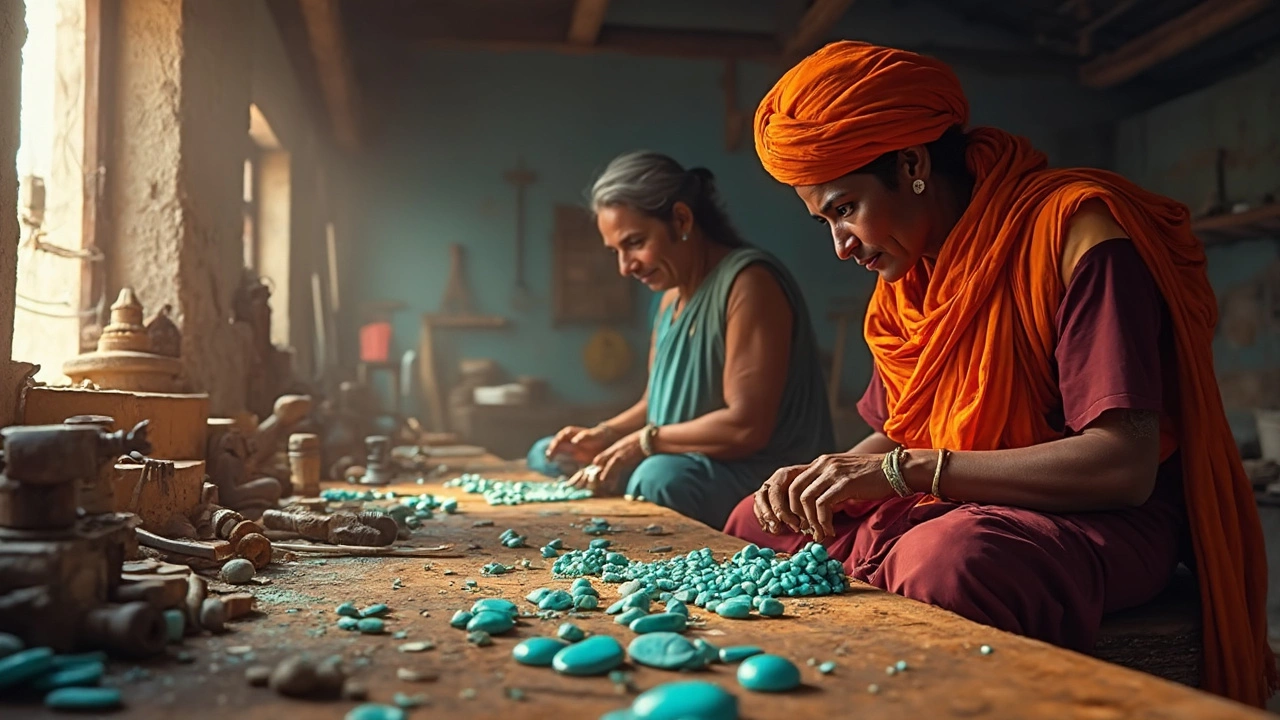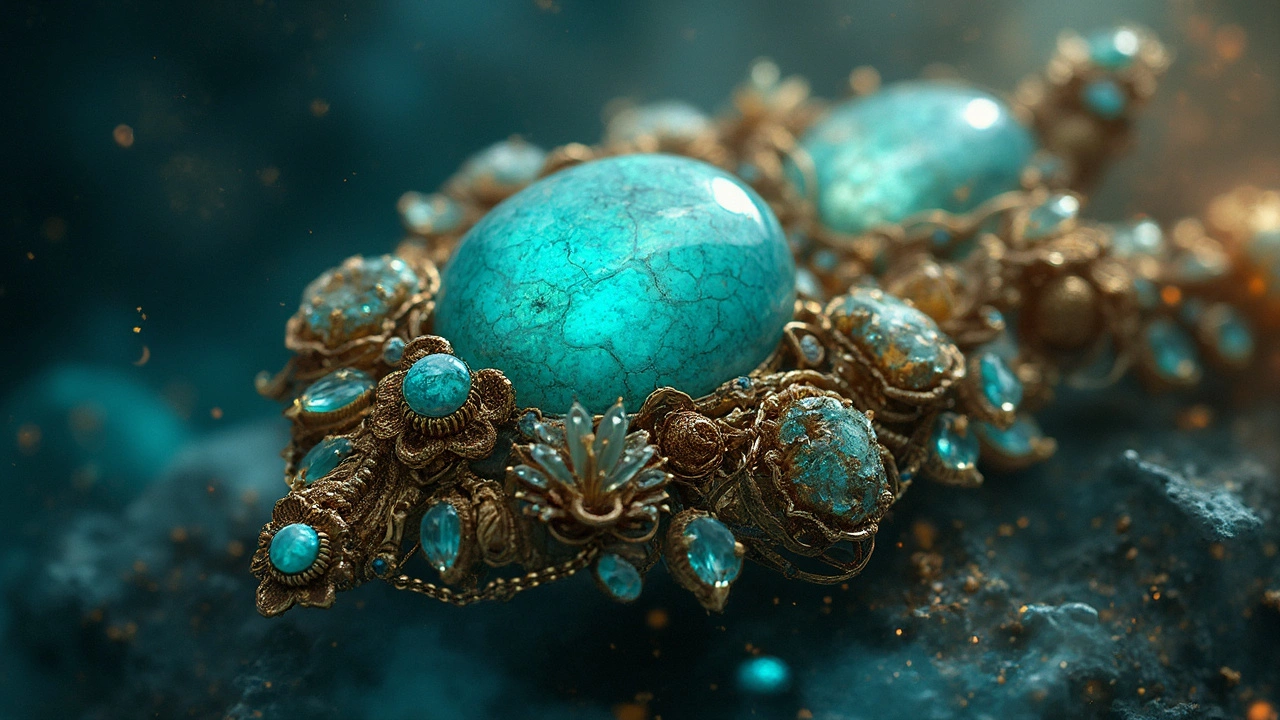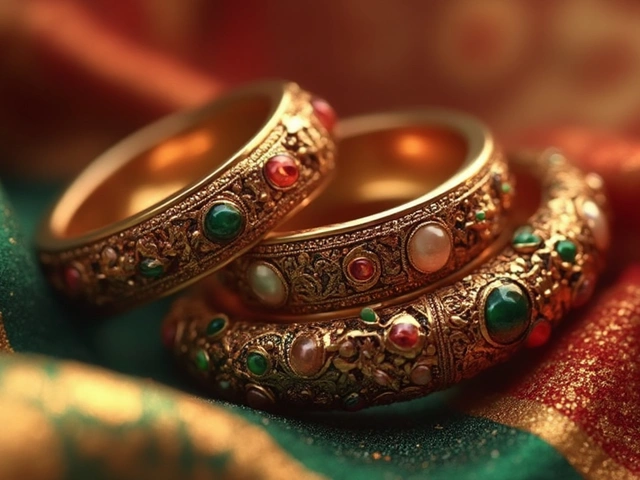Ever wondered why turquoise seems to pop up so often in Indian temple jewelry? Well, you're not alone. This stone isn't just about its captivating hue; it carries a whole lot of significance and history. For starters, turquoise is considered a symbol of protection and prosperity. In a country where spirituality weaves into everyday life, wearing turquoise isn't just about style—it's about invoking blessings.
Historically, turquoise made its way through ancient trade routes into the heart of India, becoming a staple in temple adornments. Artisans back then must have been onto something, recognizing not just the visual appeal of turquoise but its deeper resonance in the cultural psyche.
Temple jewelry is a form of art, and incorporating turquoise requires skill and precision. Craftsmen have honed their techniques over generations, blending this stone within intricate designs, usually crafted from gold. The result? Pieces that aren't just jewelry—they're a piece of living history.
- The Allure of Turquoise in Temple Jewelry
- Symbolism and Spiritual Significance
- Historical Roots and Cultural Importance
- Crafting Techniques and Artistry
- Turquoise in Modern Indian Jewelry
The Allure of Turquoise in Temple Jewelry
When it comes to Indian jewelry, especially temple ornaments, turquoise holds a special charm. It's not just about the striking color; it's about what the stone represents. Turquoise, a vibrant blue-green gem, immediately stands out in traditional settings, adding an undeniable touch of elegance.
Symbolism of Turquoise
This captivating stone is often associated with protection, healing, and positive energy. In the context of temple jewelry, it symbolizes a strong connection to divine powers. Many believe that wearing turquoise invites good fortune and guards against negative vibes. It's no wonder it's so popular in temple jewelry, where spiritual symbolism plays a huge role.
Historical Influence
The allure of turquoise dates back to ancient India. With its trade routes connecting diverse cultures, India became a hub for exquisite stones. Turquoise was traded through the Silk Road and quickly found favor among artisans. Its appeal was not just about aesthetics; it resonated with the spiritual beliefs that are entwined into Indian culture.
The craftsmanship of turquoise in Indian jewelry showcases artisanal skills passed down through generations, ensuring that the integrity of the tradition remains intact even today.
Modern Trends
Though the essence of turquoise remains unchanged, modern designs in temple jewelry have creatively adapted the stone. Asian and contemporary styles take inspiration from ancient motifs, making turquoise a versatile choice for fashionable yet meaningful pieces of temple jewelry.
No doubt, turquoise is a timeless element in both traditional and modern jewelry. So next time you spot that pop of blue-green shimmer, remember there's a rich tapestry of history and symbolism bound to it!
Symbolism and Spiritual Significance
Why is turquoise so symbolic in Indian temple jewelry? Let's just say this stone isn't just a feast for the eyes. It packs a punch of spiritual and cultural significance. In India's rich tapestry of beliefs, the color turquoise is often associated with healing, positivity, and good fortune.
The soothing blue-green of turquoise is believed to connect the earthly and the divine. Many Indian cultures hold that wearing turquoise attracts prosperity and offers protection against negative energies. It's like having your own spiritual amulet, right in your jewelry pieces!
The Protective Power of Turquoise
Imagine walking into a temple and feeling the aura of serenity. Turquoise plays a role in that ambiance. Historically, this stone was seen as a guardian against evil, offering protection to those who wore it. A fascinating fact? Rulers and warriors often adorned themselves with turquoise to safeguard their rule and their families.
"Turquoise is a stone of protection, strong and opaque, yet soothing to the touch, and healing to the eye." — Judy Hall, author of The Crystal Bible
The Cultural Impact
In temples, turquoise is often used in conjunction with other stones to amplify its protective qualities. Craftsmen might set it into gold, reflecting its status as a 'precious' stone. This combination isn't just ornamental, but symbolic of a harmony between wealth and spirituality.
Today, turquoise remains prestigious in Indian jewelry not only for its beauty but its spiritual blend, linking heritage with contemporary fashion. Ever been gifted a turquoise piece? Consider it a gesture of goodwill and protection.

Historical Roots and Cultural Importance
The story of turquoise in Indian temple jewelry is rich and fascinating, weaving through centuries of history. This gemstone wasn't always part of the Indian landscape—it journeyed along ancient trade routes, finding its place in the heart of Indian craftsmanship.
Originally, turquoise arrived from regions like Persia, today’s Iran. Through bustling trade networks, it became a coveted material for its captivating color and what it represented. Over time, Indian artisans began to integrate it into their creations, appreciating both its aesthetic allure and the energy it symbolized.
Why did it become so revered in temple decorations? Simply put, the color blue in India is deeply associated with the divine. In Hindu mythology, deities like Lord Krishna are depicted with a bluish hue, representing infinity and the vast nature of the universe. Incorporating turquoise into religious jewelry served to align these sacred pieces with spiritual ideals.
“Turquoise was revered not only for its visual beauty but also for its perceived spiritual benefits. It bridged a connection between earthly life and the divine,” says Dr. Meera Patil, a historian at the Indian Museum.
During the Chola dynasty, known for its immense influence on South Indian temple architecture and art, jewelry evolved as an essential part of temple traditions. The use of turquoise flourished as artisans from areas like Tamil Nadu crafted intricate designs, embedding this stone within golden frameworks that were both ornate and meaningful.
The Chola Influence
Among the many dynasties, the Chola reign from the 9th to 13th century marked a significant era for temple jewelry. Temples weren't just spiritual centers; they were hubs of artistic expression. Goldsmiths and jewelers, backed by royal patronage, perfected the craft, turning Indian jewelry into timeless treasures.
Fast forward to today, and the cultural importance remains. Though styles evolve, the traditional elements stay intact, resonating deeply with those who wear these pieces across generations. For many, turquoise isn't just a stone; it's a piece of a cultural tapestry, carrying forward stories from the past.
Crafting Techniques and Artistry
The art of creating Indian jewelry is nothing short of magical, especially when it comes to temple jewelry with stunning turquoise inlays. You might think it begins with the basic shaping of metal, but there's so much more to it than that. It’s about precision, patience, and a deep understanding of cultural symbolism.
The journey starts with the selection of pure gold, a preferred metal due to its malleability and traditional significance. Artisans carefully melt and shape it into sheets or wires, preparing to mold them into intricate designs that reflect divine motifs from centuries-old temple architecture.
Embedding Turquoise
Once the base is ready, the process of embedding turquoise begins. Craftsmen select the finest stones, balancing size, color, and clarity to ensure a harmonious ensemble. The stones are meticulously carved and polished, ensuring they fit perfectly within the golden design.
The Techniques Used
Traditional techniques like 'kundan' and 'jadtar' are often employed here. These involve setting the stones without prongs, ensuring that each turquoise piece stays snugly in place. The 'kundan' technique uses gold foils to hold the stones, which is a distinctive feature in Indian temple jewelry.
- Kundan: Uses gold foils to embed stones.
- Jadtar: Involves intricate stone setting with gold frames.
Details Matter
The devil is truly in the details. Artisans often use small chisels and tools to engrave delicate patterns, enhancing the stone’s natural allure. The end product is polished to a fine sheen, highlighting the vibrant blue-green of the turquoise stone against the warm glow of gold.
It's interesting to note that many artisans rely on traditional hand tools rather than modern machinery, ensuring that each piece retains its unique identity. This dedication not only keeps the tradition alive but also ensures that each piece tells its own story.

Turquoise in Modern Indian Jewelry
Today, turquoise is more than just a relic of the past; it's very much in vogue in modern Indian jewelry. From traditional ceremonial pieces to contemporary styles, this charming stone makes its mark with bold elegance.
In the bustling cityscapes of India, where technology and tradition collide, turquoise offers a cool, soothing contrast to the vibrant chaos. Jewelry designers are continually finding inventive ways to incorporate turquoise into their creations. Whether it’s necklaces, rings, or earrings, turquoise adds a refreshing twist to all sorts of jewelry.
Design Innovations
Emerging designers are mixing traditional materials like gold and silver with turquoise to create stunning fusion pieces. These often reflect a blend of modern aesthetics and age-old craftsmanship. It's about striking a balance—melding the grandeur of temple jewelry with sleek, contemporary lines that appeal to today's generation.
The Celebrity Influence
Bollywood stars and influencers gravitate towards turquoise jewelry, further popularizing it among the masses. Pictures of them adorned in glimmering turquoise pieces flood social media, sparking trends among fashion-savvy individuals. This vibrant exposure contributes to the stone's enduring popularity.
A Trend With Depth
The appeal of turquoise is not just skin deep. Aside from its striking appearance, it is thought to have healing properties and bring emotional balance. With sustainability becoming a buzzword in all industries, jewelry made with turquoise, a durable and lasting stone, is seen as a wise investment.
Whether you're into statement jewelry or subtle styles, incorporating turquoise into your collection is a brilliant way to spice up your look. By choosing pieces that feature this time-honored stone, you're not just wearing jewelry—you're showcasing a piece of Indian cultural heritage and style.



